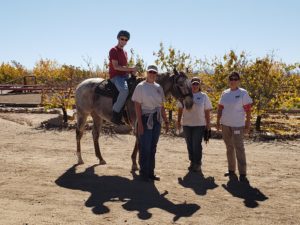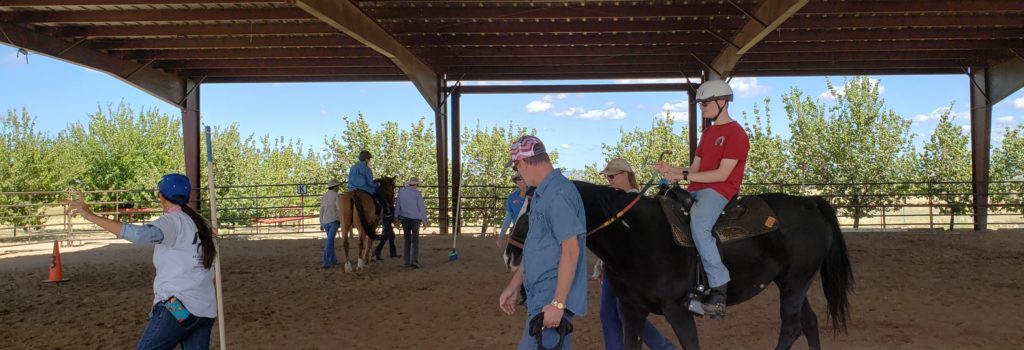Equine Therapy

My nephew, Paul, is deaf and autistic. Doing equine therapy at a facility in Arizona called Horses with HEART Inc. (HwH) has helped him with balance, strength, confidence and increased social interaction with his family. Paul is pictured here with his support team and Rosie, the horse.
Winston Churchill is credited with the famous quote, “There’s something about the outside of a horse that’s good for the inside of a man.” In recent years, the medical and psychology fields have been proving that statement to be true. Although it is not new, equine therapy has gained a lot of attention and popularity due to its positive effect on people with a wide range of conditions. Horses have been used in many capacities to help individuals with conditions such as: autism, Down syndrome, psychological trauma (PTSD), anxiety, stress, addiction and a multitude of other mental and physical disabilities.
Equine therapy has been around for a while. It is mentioned in the 400s BC. Hippocrates wrote about the therapeutic benefits of horses. Ancient Greeks used horses to help people with chronic diseases. People began to really pay attention to the value of equine therapy when Liz Hartel from Denmark won a silver medal for dressage in the 1952 Olympics. Her legs had been paralyzed from polio as child but with equine therapy she was able to make remarkable improvements in her movement on and off of a horse. (Scott, N. Special Needs, Special Horses: A Guide to the Benefits of Therapeutic Riding. 2005)
The North American Riding for the Handicapped Association (NARHA) was developed in 1969. It has been the leading organization of equine therapy since although they changed the name to Professional Association of Therapeutic Horsemanship International (PATH Intl.) in 2011. They have 873 centers worldwide to assist those in need. (https://www.pathintl.org/)
PATH promotes the benefits of therapeutic horseback riding as well as other equine assisted activities. PATH defines equine assisted activities:
Equine-Assisted Therapy has a more specific goal. It is a treatment which uses horses to reach rehabilitative goals that are bounded by a medical professional’s scope of practice. Equine-Assisted Therapy is not an activity run by local horse clubs, church groups, or trainers. Instead, it is overseen by a medical professional, usually a licensed psychotherapist or physical therapist. Equine-Facilitated Psychotherapy, which is used by addiction treatment facilities, veterans’ groups, and trauma centers, is always overseen by a licensed mental health professional. (Scharff, C. Therapeutic Value of Horses. August 23, 2017)
Some people have wondered, “Why horses?” What’s wrong with dogs and cats, etc.? While many different types of pets may be used for healing, horses have unique qualities of their own. Michelle Howell-Smith, of University of Nebraska Lincoln, who is doing a lot of research into the benefit of equine based therapies, explains, “A horse is not something that you typically have in your home. That you have access to on a daily basis…So it’s getting out of your normal environment, interacting with an animal that’s not part of your daily routine. Horses are very large.” (McDermott, B. NET News. UNL Researcher Focuses On Horse Therapy For ADHD And Autism. 24 Oct 2019).
In addition, horses are prey animals and herd animals. Horses depend on communication with those around them to make sense of an environment. Horses are constantly assessing their surroundings and those they are in close quarters with. When horses meet people, they size them up the way that they would another horse. Horses want to know where a person fits into the herd. Howell-Smith believes that this nonverbal communication is a “powerful therapeutic tool that’s different than what a cat or dog might do on a daily basis.”
Recently, researchers from the Universities of Sussex and Portsmouth showed that horses are extremely perceptible of human emotion. They found that horses could read human emotions and then remember that previous emotional state later that day and adapt their behavior accordingly (Proops, L., Grounds, K., Smith, A., McComb, K. Animals Remember Previous Facial Expressions that Specific Humans Have Exhibited. Current Biology. Vol.28, Issue 9. April 26, 2018.):
“To see if horses had a knack for responding to the emotions we wear on our face, the researchers tested them with photographs displaying angry and happy expressions. They found that the subjects’ showed negative reactions and increased heart rate to the more aggressive looking images. Surprisingly, they also showed a bias in how they looked at the images, turning their head to gaze at it with their left eye, possibly thanks to differences in how their brain’s hemispheres process threatening stimuli. To follow up on this study, the team recently went back to the stable and used the same basic method to test if the response had a lasting impact on how 24 different horses in four locations across Sussex treated the people behind the smiles and snarls. A few hours after seeing a photograph of an individual grinning or frowning, the horses got to meet the subject in the picture. Only this time the person wore a neutral expression. It didn’t matter – the horses appeared to remember the person and their mood, using different sides of their head to look while displaying an elevated heart rate for those they recalled as looking rather grumpy. Horses are incredibly intelligent animals that pick up on the smallest shifts in posture.” (McRae, M. Sciencealert.com/horses-recognise-and-remember-emotional-human-facial-expressions. 27 April 2018)
Of this research, University of Portsmouth psychologist, Leanne Proops said, “We know that horses are socially intelligent animals, but this is the first time any mammal has been shown to have this particular ability.” This may explain, in part, why horses are so valuable as therapy animals.
Here at Butler Professional Farrier School, we have seen first-hand the positive effects of equine therapy. We trim the horses at a local equine therapy facility in Alliance, Nebraska, called East Point Horspice (EPH). Run by Charlene and Brian Stephenson, the goal of East Point Horspice is to “provide the possibility for people with physical and emotional issues to be exposed to the horse’s honest, genuine, and compassionate nature.” They state the benefits of equine therapy on their website:
“Horses demonstrate, daily, an unsurpassed ability to provide a remarkable, life changing experience and EPH hopes to share this with those who need it most. Equine movement provides multidimensional movement, which is variable, rhythmic and repetitive. The horse provides a dynamic base of support, making it an excellent tool for increasing trunk strength and control, balance, building overall postural strength and endurance, addressing weight bearing and motor planning. Equine movement offers well-modulated sensory input to vestibular, proprioceptive, tactile and visual channels. During gait transitions, the rider must perform subtle adjustments in the trunk to maintain a stable position. When a rider is sitting forward astride the horse, the horse’s walking gait imparts movement responses remarkably similar to a normal human gait. The effects of equine movement on postural control, sensory systems, and motor planning can be used to facilitate coordination and timing, grading of responses, respiratory control, sensory integrations skills and attention skills. Equine movement can be used to facilitate the neurophysiologic systems that support all of our functional daily living skills.” (eastpointhorspice.com)
We’ve also seen several students come through the horseshoeing program here that have gone through some healing of their own. Some US military veterans that have suffered from Post Traumatic Stress Disorder (PTSD) have found a renewed sense of purpose and joy in their new jobs as farriers. Working with horses, as a farrier, being part of a solution to help horses feel better can be very therapeutic.
My nephew, Paul is deaf and he has autism and cerebral palsy. He has had a great deal of success in building his balance, strength and confidence through equine therapy. My sister said of his experience with the program:
Paul has improved in confidence as well as balance. We have also noticed an increase in reduced stress and frustrations with his autism as riding and being around horses calms Paul. His muscle strength has increased as well. Paul has really engaged more with the family and I feel this is largely because of his “sport” that we are all supporting him in. On his second day (2nd week) of class our family went to watch Paul ride. He smiled a lot that day and was so appreciative of us being there. I have noticed Paul being more involved in our family meal discussions and being happier around his step-siblings. (personal email from CindyLee Butler Bushman, 7 November 2019)

Paul riding Jewel at Horses with HEART Inc. in Northern Arizona (https://www.horseswithheartaz.org/)
Dr. Howell-Smith stated that equine therapy for her own five year old daughter with autism brought about noticeable behavioral changes:
“We saw her instead of just playing around groups of children. She would say, ‘Mommy, can we go make a new friend to play with?’ And so I would help her go make a new friend. Then pretty soon, she didn’t need my help anymore, she would just say, ‘Mom, I’m going to go make a new friend’ and would cope and do that. She became more interested in self-care and wanting to wash herself in the bathtub or choose what clothes she was going to wear, things that she had no interest in previously. It really just sort of turned a light on in her…”
Dr. Howell-Smith’s research now is focused on quantifying what is actually happening to a person physiologically during and after equine therapy. Stress is measured through hormones in the saliva and MRI screens. Baseline information is taken for what stress and anxiety look like in a typical day and then compared against MRI screens taken immediately after the equine therapy. Dr. Howell-Smith says, “ [the]hope is that the children are able to be calmer, less anxious, have more connectivity going on in their brain as a result of their experiences, interacting with the horses and riding the horses.” (McDermott, B.)
Though the how may not be completely understood yet, the effect of equine therapy for thousands of individuals is undeniable. Horses have a profound effect on our lives. As farriers, we are fortunate because we get to work with horses and ensure that they feel their best so they can do their job to help others.
Related Posts
-
It’s important to have a memorized sequence of perform...Jan 29, 2010 / 0 comments
-
Since horses can make a difference in our lives, and even ch...Dec 04, 2012 / 0 comments
-
The royal wedding in England has captured the attention and ...May 03, 2011 / 0 comments
Blog Categories
- Anatomy
- Best Business Practices
- Conformation
- Current Events
- Customer Service
- Draft Horse Shoeing
- Equine Soundness
- Essential Anatomy Kit
- Farrier Careers
- Farrier training
- Foal soundness
- Horse Care
- Horse Foot Care
- Horse Owner Tips
- Horsemanship
- Horseshoeing
- Horseshoeing History
- Iron and Forge Work
- Student Spotlight
- Uncategorized
- Veterinary Care
Blog Archives
Contact Us
Butler Professional Horseshoeing School
495 Table Road
Crawford, NE 69339
(800) 728-3826
jacob@dougbutler.com
Subscribe to Our Blog
Get Our Free e-Book!
If you think you want to become a farrier (or know someone who does), this book can help you make that decision. Horse owners will learn the importance of choosing a qualified farrier and how to select the “right” one.
[ Get the e-Book Now! ]
- Follow:
